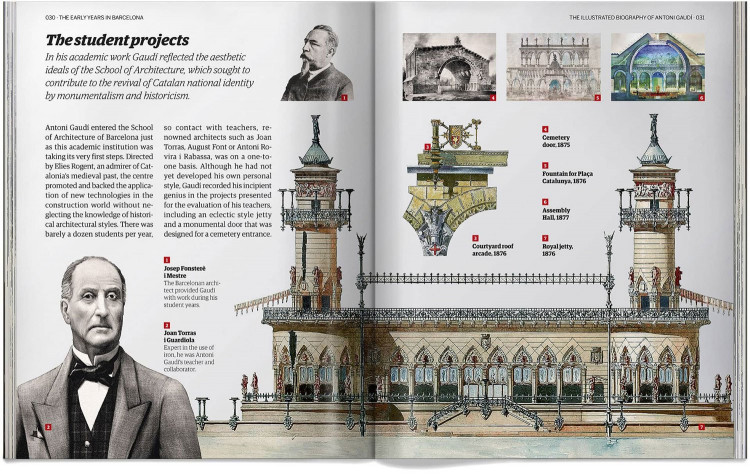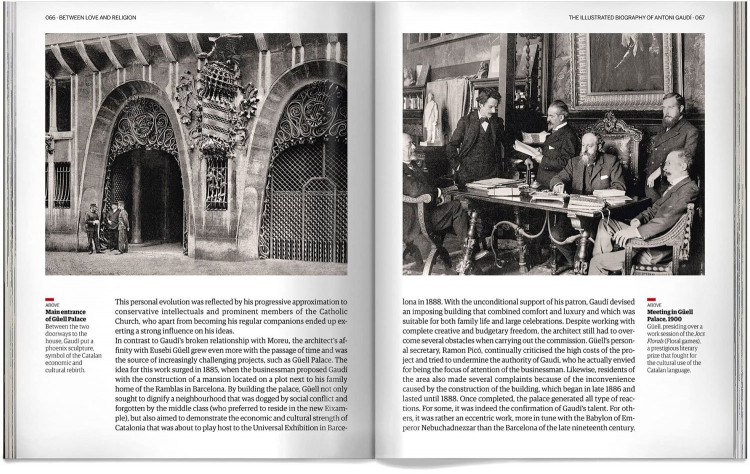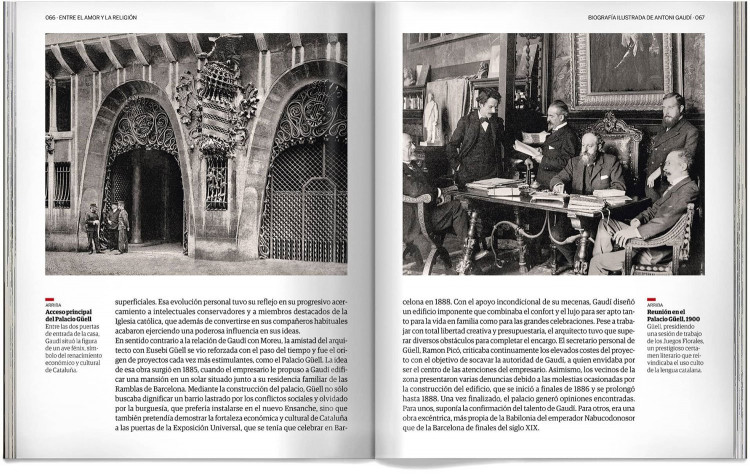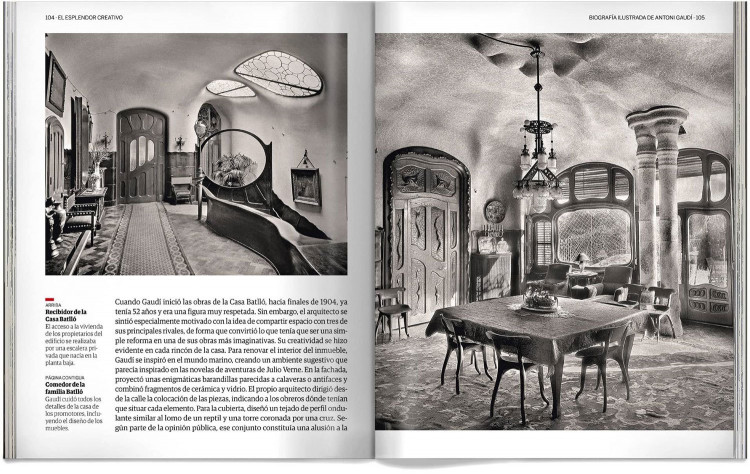The Illustrated Biography of Antoni Gaudí
RETURN
About the book Biography of Gaudí
This biography of Antoni Gaudí unveils the most important episodes in the architect's personal life and professional career. Within its pages the reader will be able to discover the success, the misfortunes and the secrets of an often misunderstood character, blessed with an incredible imagination and abundant creativity.
This book published by Dosde is the first illustrated biography of Gaudí that exists on the market. Following an enormous task of photo documentation, carried out over a time span of more than a year, the result is one of the most complete biographies on Gaudí's work, both from an informative and visual point of view, which covers the life of the brilliant architect in great detail.
The book contains more than 150 historical images of Gaudí's personal and professional life, and includes illustrations, information about the period and original sketches of his creations.
In chronological order, the book carries out a detailed analysis of his life, his career, his architectonic style and the works that converted him into an internationally recognised architect. Due to its didactic character and photographic documentation work, this book unveils the life and work of Gaudí in an easy-to-read yet thorough way, offering a privileged look at the career of this brilliant architect.
This book published by Dosde is the first illustrated biography of Gaudí that exists on the market. Following an enormous task of photo documentation, carried out over a time span of more than a year, the result is one of the most complete biographies on Gaudí's work, both from an informative and visual point of view, which covers the life of the brilliant architect in great detail.
The book contains more than 150 historical images of Gaudí's personal and professional life, and includes illustrations, information about the period and original sketches of his creations.
In chronological order, the book carries out a detailed analysis of his life, his career, his architectonic style and the works that converted him into an internationally recognised architect. Due to its didactic character and photographic documentation work, this book unveils the life and work of Gaudí in an easy-to-read yet thorough way, offering a privileged look at the career of this brilliant architect.
Visual Edition
The Illustrated Biography of Antoni Gaudí
It includes exclusive digital content
Made with environmentally friendly paper
Multilanguage: Available in 8 languages
More than 150 top quality photographs
About the book Biography of Gaudí
This biography of Antoni Gaudí unveils the most important episodes in the architect's personal life and professional career. Within its pages the reader will be able to discover the success, the misfortunes and the secrets of an often misunderstood character, blessed with an incredible imagination and abundant creativity.
This book published by Dosde is the first illustrated biography of Gaudí that exists on the market. Following an enormous task of photo documentation, carried out over a time span of more than a year, the result is one of the most complete biographies on Gaudí's work, both from an informative and visual point of view, which covers the life of the brilliant architect in great detail.
The book contains more than 150 historical images of Gaudí's personal and professional life, and includes illustrations, information about the period and original sketches of his creations.
In chronological order, the book carries out a detailed analysis of his life, his career, his architectonic style and the works that converted him into an internationally recognised architect. Due to its didactic character and photographic documentation work, this book unveils the life and work of Gaudí in an easy-to-read yet thorough way, offering a privileged look at the career of this brilliant architect.
This book published by Dosde is the first illustrated biography of Gaudí that exists on the market. Following an enormous task of photo documentation, carried out over a time span of more than a year, the result is one of the most complete biographies on Gaudí's work, both from an informative and visual point of view, which covers the life of the brilliant architect in great detail.
The book contains more than 150 historical images of Gaudí's personal and professional life, and includes illustrations, information about the period and original sketches of his creations.
In chronological order, the book carries out a detailed analysis of his life, his career, his architectonic style and the works that converted him into an internationally recognised architect. Due to its didactic character and photographic documentation work, this book unveils the life and work of Gaudí in an easy-to-read yet thorough way, offering a privileged look at the career of this brilliant architect.
Videos The Illustrated Biography of Antoni Gaudí
Readers opinions
(5)
RETURN
Reviews
(5)
Highly recommended!
The content is of a high quality and it is a very complete book.
Very good books, to know Gaudí completely and the works he did
Very good book, the purchase was worth it.
Highly recommendable. The information is very detailed, rigorous and it is a high quality book.
Readers opinions
(5)
Highly recommended!
The content is of a high quality and it is a very complete book.
Additional Information
- Additional Information
- Subtitle: No
- Weight (g): 515
- Binding: Paperback
- Size (cm): 16,5 x 20,5
- Author: Dosde
- Pages: 0
- Edition: Visual Edition
Biography of Antoni Gaudí
Considered as one of the most influential architects in history, Antoni Gaudí was both a controversial and enigmatic figure. Architect of universal works such as the Sagrada Familia, Park Güell, Casa Batlló and La Pedrera, the Catalan architect experienced all kinds of situations during his life that influenced his personal development.
Born into a modest family of craftsmen, Gaudí ended up converting into one of the great references of modernist architecture thanks to his strong personality. His perseverence not only meant he could overcome the technical limitations of the time and develop his own personal style, but also allowed him to face adversities such as illness, heartbreak or the death of loved ones.
Antoni Gaudí's early childhood was spent in Baix Camp, a region of southern Catalonia that was marked out by mountain ranges and the Mediterranean coast. It was here where the future architect of the Sagrada Familia began developing his aesthetic sensibility and observation skills, inherited from his parents, Francesc Gaudí and Antònia Cornet, from modest family backgrounds with a long tradition of craftsmanship.
The exact place where Gaudí was born has been the subject of much debate over the years, though most experts believe the architect came into the world in the city of Reus, on the 25th of June, 1852. Just a few hours after he was born, Gaudí was baptised in the parish church of Sant Pere de Reus, a clear sign that his parents feared for the delicate health of their newly-born.
Antoni Gaudí proved to be a sickly child, suffering with rheumatism problems that persisted and stayed with him until his final days. Because of this chronic condition, often the small Antoni was obliged to stay in bed, unable to walk, while his siblings had fun playing outdoors or helping their parents.
The Gaudí family resided in a modest house in the centre of Reus. On the ground floor was the workshop where Gaudí's father carried out his profession. It was here where the iron and copper boilers were manufactured that families would use to heat household water.
Moreover, he created special pieces for companies that were dedicated to the production of alcoholic beverages, which had a significant presence in Reus from the eighteenth century.
Gaudí and his family would often go to Riudoms, where Francesc still maintained the house and the studio of the architect's paternal grandfather, (who was also a boilermaker), as well as a farm property called Mas de la Calderera (Farm of the Boilermaker), which was on the outskirts of town and had several plots for growing fruit and vegetables and raising livestock.
There, Gaudí spent his time playing with the chickens, observing insects and studying nature, which he would later assure, was indeed his great teacher and inspiration.
With a budget that left very little room for choice, Francesc and Antoni chose to settle in La Ribera (the waterfront), which was one of the busiest districts of the old town.
In 1874 Gaudí was accepted at the School of Architecture, whose classes were held in a neo-medieval building of recent construction bordering the Raval and the Eixample districts. In order to acquire the necessary experience and cover the costs of his architectural degree, he architect worked for a while as a draftsman for Josep Fontserè.
During his student years, Gaudí also worked for other established architects, such as Francisco de Paula del Villar and, above all, Joan Martorell, who in the years to come was his guide and mentor, carrying out a key role in the biography of Gaudí.
After completing the four year course of the architecture degree, on the fifteenth of March, 1878 Antoni Gaudí qualified as an architect. It was not a simple process, as his final results did not have the unanimous approval of his teachers. In fact, the director of the School of Architecture, Elies Rogent said he was unable to discern whether they were awarding the title to a genius or a madman. These types of doubts about the architect's talent would be a constant in Gaudí's biography.
In February 1883, Gaudí presented the plans for his first major work, the Casa Vicens. It was a summer residence designed for Manuel Vicens i Montaner, a tile manufacturer who had inherited land belonging to his mother in the village of Gràcia, which was then an independent municipality located on the outskirts of Barcelona.
The design of the Casa Vicens had similarities with another project initiated by Gaudí in 1883 in the town of Comillas: the Caprice, a building that was bursting with energy that transgressed the formal conventions of the time with its mix of architectural styles and its colourful decoration, which included allusions to music and botany.
In 1883 Gaudí also accepted his most transcendental commission: the construction in Barcelona of an expiatory temple dedicated to the Holy Family. Gaudí was hired to replace Francisco de Paula del Villar, who had resigned from the project due to budgetary restrictions, and took on the challenge with his typical enthusiasm.
During the last quarter of the nineteenth century, Gaudí received commissions at a frenetic pace. He was becoming increasingly popular and his future looked as if it could only but thrive.
With the start of the construction of the Temple of the Sagrada Familia and the projects backed by his main patron, the industrialist Eusebi Güell, his financial stability was ensured for a long period, while the urban growth of Barcelona guaranteed a prosperous horizon, with new ventures linked to a bourgeoisie that regarded architecture as a means of displaying their rising strength and power.
During this period, Gaudí designed in Barcelona Güell Palace, Park Güell, the Teresian College and Casa Calvet. Likewise, the architect created in the coastal town Garraf some striking winecellars for Eusebi Güell, and travelled on several occasions to the province of León in order to work on the Episcopal Palace of Astorga and Casa Botines.
With the arrival of the twentieth century Gaudí began his most creative period and reached full artistic maturity. It was during these years when Gaudí's biography included great masterpieces of architecture such as La Pedrera-Casa Milá, Casa Batlló and the Crypt of the Colonia Güell, projects that showed the stylistic evolution of their creator, who was more and more interested in using nature as his inspiration when creating structures and shapes.
From 1914, Gaudí worked exclusively on the Sagrada Familia. The architect, who had taken over the management of the building work in the early days of his career thanks to a series of coincidences, made the Sagrada Familia his living testament.
Gaudí had always admired the masters of medieval works, builders of great monumental cathedrals that defied the passage of time. He wanted to go even further. He had taken it on himself to create the perfect temple, a building of colossal dimensions that would act as the ideal setting for religious worship and at the same time, incorporate constructive resources that had been developed throughout his career to overcome the technical limitations of the Gothic genre.
Gaudí took the construction of the Sagrada Familia quite calmly. As he himself said, "the Master of the work", God, was in "no hurry". The completion of Barcelona's cathedral had been delayed for centuries, so Gaudí's temple, even more complex, was neither going to be built from one day to the next.
However, the architect was optimistic about the future of the basilica. Still, Gaudí was aware of the precariousness of the continuity of the project on several occasions.
The works were financed exclusively by contributions from worshippers and any abrupt fall in donations had serious consequences. The architect was therefore unable to maintain a regular work rhythm.
Not even his team of workers was stable. When the economic situation of the board of trustees of the temple became critical, he was forced to dispense with dozens of workers, not knowing when he would be able to recontract them.
After being examined by a doctor, the architect, who suffered concussion and several broken ribs, was transferred to the Hospital de la Santa Creu, in the Raval district. After some hours of agony, on the tenth of June, at five o'clock in the afternoon, Gaudí passed away.
The funeral, held on the twelfth of June, was a multitudinous affair. Gaudí was buried in the crypt of the Sagrada Familia, in the Chapel of Carmen. This was how he achieved his final union was his most grandiose project, the testimony of all the dreams and aspirations of a life devoted entirely to architecture.
Born into a modest family of craftsmen, Gaudí ended up converting into one of the great references of modernist architecture thanks to his strong personality. His perseverence not only meant he could overcome the technical limitations of the time and develop his own personal style, but also allowed him to face adversities such as illness, heartbreak or the death of loved ones.
Gaudí's childhood
Antoni Gaudí's early childhood was spent in Baix Camp, a region of southern Catalonia that was marked out by mountain ranges and the Mediterranean coast. It was here where the future architect of the Sagrada Familia began developing his aesthetic sensibility and observation skills, inherited from his parents, Francesc Gaudí and Antònia Cornet, from modest family backgrounds with a long tradition of craftsmanship.The exact place where Gaudí was born has been the subject of much debate over the years, though most experts believe the architect came into the world in the city of Reus, on the 25th of June, 1852. Just a few hours after he was born, Gaudí was baptised in the parish church of Sant Pere de Reus, a clear sign that his parents feared for the delicate health of their newly-born.
Antoni Gaudí proved to be a sickly child, suffering with rheumatism problems that persisted and stayed with him until his final days. Because of this chronic condition, often the small Antoni was obliged to stay in bed, unable to walk, while his siblings had fun playing outdoors or helping their parents.
The Gaudí family resided in a modest house in the centre of Reus. On the ground floor was the workshop where Gaudí's father carried out his profession. It was here where the iron and copper boilers were manufactured that families would use to heat household water.
Moreover, he created special pieces for companies that were dedicated to the production of alcoholic beverages, which had a significant presence in Reus from the eighteenth century.
Gaudí and his family would often go to Riudoms, where Francesc still maintained the house and the studio of the architect's paternal grandfather, (who was also a boilermaker), as well as a farm property called Mas de la Calderera (Farm of the Boilermaker), which was on the outskirts of town and had several plots for growing fruit and vegetables and raising livestock.
There, Gaudí spent his time playing with the chickens, observing insects and studying nature, which he would later assure, was indeed his great teacher and inspiration.
The move to Barcelona
In autumn 1868, at the age of sixteen, Gaudí left his native Reus and headed for Barcelona. In Barcelona, the young Antoni could count on the company of his brother, Francesc, who was about to embark on a medical career, which was quite a feat for a member of a modest family of coppersmiths ,whom until that time had had no contact with the university world.With a budget that left very little room for choice, Francesc and Antoni chose to settle in La Ribera (the waterfront), which was one of the busiest districts of the old town.
In 1874 Gaudí was accepted at the School of Architecture, whose classes were held in a neo-medieval building of recent construction bordering the Raval and the Eixample districts. In order to acquire the necessary experience and cover the costs of his architectural degree, he architect worked for a while as a draftsman for Josep Fontserè.
During his student years, Gaudí also worked for other established architects, such as Francisco de Paula del Villar and, above all, Joan Martorell, who in the years to come was his guide and mentor, carrying out a key role in the biography of Gaudí.
The path to success
After completing the four year course of the architecture degree, on the fifteenth of March, 1878 Antoni Gaudí qualified as an architect. It was not a simple process, as his final results did not have the unanimous approval of his teachers. In fact, the director of the School of Architecture, Elies Rogent said he was unable to discern whether they were awarding the title to a genius or a madman. These types of doubts about the architect's talent would be a constant in Gaudí's biography.In February 1883, Gaudí presented the plans for his first major work, the Casa Vicens. It was a summer residence designed for Manuel Vicens i Montaner, a tile manufacturer who had inherited land belonging to his mother in the village of Gràcia, which was then an independent municipality located on the outskirts of Barcelona.
The design of the Casa Vicens had similarities with another project initiated by Gaudí in 1883 in the town of Comillas: the Caprice, a building that was bursting with energy that transgressed the formal conventions of the time with its mix of architectural styles and its colourful decoration, which included allusions to music and botany.
In 1883 Gaudí also accepted his most transcendental commission: the construction in Barcelona of an expiatory temple dedicated to the Holy Family. Gaudí was hired to replace Francisco de Paula del Villar, who had resigned from the project due to budgetary restrictions, and took on the challenge with his typical enthusiasm.
Creative splendour
During the last quarter of the nineteenth century, Gaudí received commissions at a frenetic pace. He was becoming increasingly popular and his future looked as if it could only but thrive.With the start of the construction of the Temple of the Sagrada Familia and the projects backed by his main patron, the industrialist Eusebi Güell, his financial stability was ensured for a long period, while the urban growth of Barcelona guaranteed a prosperous horizon, with new ventures linked to a bourgeoisie that regarded architecture as a means of displaying their rising strength and power.
During this period, Gaudí designed in Barcelona Güell Palace, Park Güell, the Teresian College and Casa Calvet. Likewise, the architect created in the coastal town Garraf some striking winecellars for Eusebi Güell, and travelled on several occasions to the province of León in order to work on the Episcopal Palace of Astorga and Casa Botines.
With the arrival of the twentieth century Gaudí began his most creative period and reached full artistic maturity. It was during these years when Gaudí's biography included great masterpieces of architecture such as La Pedrera-Casa Milá, Casa Batlló and the Crypt of the Colonia Güell, projects that showed the stylistic evolution of their creator, who was more and more interested in using nature as his inspiration when creating structures and shapes.
The latter years in Gaudí's biography
From 1914, Gaudí worked exclusively on the Sagrada Familia. The architect, who had taken over the management of the building work in the early days of his career thanks to a series of coincidences, made the Sagrada Familia his living testament.Gaudí had always admired the masters of medieval works, builders of great monumental cathedrals that defied the passage of time. He wanted to go even further. He had taken it on himself to create the perfect temple, a building of colossal dimensions that would act as the ideal setting for religious worship and at the same time, incorporate constructive resources that had been developed throughout his career to overcome the technical limitations of the Gothic genre.
Gaudí took the construction of the Sagrada Familia quite calmly. As he himself said, "the Master of the work", God, was in "no hurry". The completion of Barcelona's cathedral had been delayed for centuries, so Gaudí's temple, even more complex, was neither going to be built from one day to the next.
However, the architect was optimistic about the future of the basilica. Still, Gaudí was aware of the precariousness of the continuity of the project on several occasions.
The works were financed exclusively by contributions from worshippers and any abrupt fall in donations had serious consequences. The architect was therefore unable to maintain a regular work rhythm.
Not even his team of workers was stable. When the economic situation of the board of trustees of the temple became critical, he was forced to dispense with dozens of workers, not knowing when he would be able to recontract them.
Gaudí's death
On the seventh of June, 1926, Gaudí, who was about to turn 74 years old, followed his usual Monday routine. After finishing his working day in the Sagrada Familia, he went to the Church of Sant Felip Neri. It was a little after six o'clock in the evening when he arrived at the junction where two of the Eixample's streets Carrer Bailen and Gran Vía converge. At that precise moment he was knocked down by a tram.After being examined by a doctor, the architect, who suffered concussion and several broken ribs, was transferred to the Hospital de la Santa Creu, in the Raval district. After some hours of agony, on the tenth of June, at five o'clock in the afternoon, Gaudí passed away.
The funeral, held on the twelfth of June, was a multitudinous affair. Gaudí was buried in the crypt of the Sagrada Familia, in the Chapel of Carmen. This was how he achieved his final union was his most grandiose project, the testimony of all the dreams and aspirations of a life devoted entirely to architecture.


































